KCVC Graduates 1900-1904
| Claude M. McFarland (1900) |
Claude M. McFarland was born in Ness County, Kansas, July 9, 1877. He attended high school in Kansas City and was first appointed in the Bureau of Animal Industry (BAI) as a laborer at Kansas City on March 21, 1897. He resigned to enter the KCVC and graduated from the KCVC in 1900 with a D.V.S. degree. He was appointed Assistant Inspector at Cincinnati on June 6, 1900, after a civil service examination (Salmon 1901). In 1902, it was reported that Dr. McFarland of Billings, Montana, had entered the meat inspection service of the BAI and was now stationed at South St. Joseph, Missouri (J. Comp. Med. Vet. Arch. 22:466, 1902). In 1911, McFarland was serving as inspector of stock in St. Joseph, Missouri (Morgan 1911). In 1921, the JAVMA reported that McFarland, formerly located at Fort Worth, Texas, as Vice-President of the Purity Serum Company, has moved to Kansas City, Missouri, where he is associated with the Sihler Serum Company as Sales Manager.
| Willis H. Meadors (1900) |
Willis H. Meadors was born at Lafayette, Alabama, February 21, 1874. He attended the KCVC, graduating in 1900 with a D.V.S. degree. The Journal of Comparative Medicine and Veterinary Archives notes that the ninth annual commencement and banquet of the KCVC were held in the Midland Hotel, Kansas City, on March 14, 1900 at 8 p.m. He was appointed an Assistant Inspector in the Bureau of Animal Industry (BAI) in Kansas City on June 1, 1900, after a civil service examination (Salmon 1901). He died in 1955.
| Joseph W. Parker (1900) |
Joseph W. Parker was born in Moniteau County, Missouri, October 30, 1867. He attended the public schools and took a teacher's course at Otterville College, Otterville, Missouri, receiving a B.S. degree. He taught school for eight terms and was engaged in newspaper work for four years. On May 1, 1897, he was appointed from Green Ridge, Missouri, as a clerk in the quarantine service in Kansas City. He subsequently entered the KCVC, graduating in 1900 with a D.V.S. degree. He was promoted to Assistant Inspector on June 12, 1900, after passing the civil service examination. On September 10, 1900, he was transferred to South St. Joseph, Missouri (Salmon 1901). From 1900-1901, he also was on the faculty of the KCVC where he taught comparative anatomy (Lee 1956). In 1906, he was an Inspector with the Bureau of Animal Industry (BAI) in Texas and reported on the use of an arsenical cattle dip for ticks.
| Richard Frederick Eagle (1901) |
Richard Frederick Eagle was born in Kansas City, Kansas, on June 17, 1879. "Fred," as he was known to his host of friends, grew to manhood in that city and it was quite natural, in that stockyards and packing-house environment, that his interests turned towards livestock and he decided upon veterinary medicine as a life career. He graduated from the KCVC in 1901 in a class of 12 students. Soon after graduation, he accepted a contract as civilian veterinarian with the Remount Division of the British Army in connection with the shipment of 1,147 horses to Africa. After delivery of these animals at Port Elizabeth, with only a very insignificant loss, he turned his journey into a "round-the-world" tour.
While on the African trip he was offered an appointment in the United States Bureau of Animal Industry (BAI) and upon his return to this country accepted and began his Bureau service at the National Stock Yards, East Saint Louis, Illinois, on August 16, 1901. Between this date and January 26, 1913, he served the Bureau in various capacities in connection with the meat inspection service at National Stock Yards, South St. Joseph, Kansas City, Chicago, and Fort Worth. Also during this period, in 1905-06, he was assigned to sheep scabies work in North Dakota, and in 1908 did foot-and-mouth disease work in Pennsylvania.
Following his resignation from the Bureau, Dr. Engle entered the service of Schwarzchild and Sulzberger, packers, with which firm and its successor, Wilson and Company, he continued working and eventually occupied the position of vice-president.
Dr. Eagle's principal interest was in the packing industry; however, he never lost contact with, or interest in, the veterinary profession. An outstanding example of this interest occurred in 1917, when he was instrumental in interesting Mr. Thomas E. Wilson, president of Wilson and Company, in a plan to establish a veterinary section in the gallery of the Saddle and Sirloin Club in Chicago. Mr. Wilson not only took a personal interest in the plan but contributed a fund as a basis for its establishment.
At the meeting of the AVMA in Philadelphia in August 1918, the portraits of Drs. Daniel E. Salmon, Alonzo D. Melvin, and John R. Mohler were presented by Dr. Eagle on behalf of the Art Committee of the Saddle and Sirloin Club, with the understanding that the association would return the portraits to the club for the gallery it had opened for distinguished veterinarians. Later, in addition to the above, the portrait of Dr. James Law, contributed by the alumni of the New York State Veterinary College at Cornell University, and that of Dr. Leonard Pearson, contributed by the alumni of the School of Veterinary Medicine of the University of Pennsylvania, were presented to the club and received by its President, Mr. A.H. Sanders. Canada also contributed an oil painting of Dr. J.G. Rutherford. Later, portraits of Drs. M. Dorset, S.E. Bennett, H.J. Detmers and Mark Francis were added to the gallery and all were in one group in the southwest corner of the Main Hall of the Saddle and Sirloin Club at the Union Stock Yards in Chicago as a lasting tribute to these men and the profession that had done so much to better the livestock industry of the country.
Fred Eagle managed to find the time to attend most of the important veterinary meetings and seldom missed the opportunities to meet and mingle with his colleagues. On such occasions his genial personality, his unlimited fund of appropriate stories, and his well-known ability in the role of toastmaster invariably
added to the success and enjoyment of the gathering. His selection for this position at the AVMA banquet on the occasion of the 75th annual meeting in
New York, July 5-9, 1938, insured an affair that no one in attendance at the meeting wanted to miss.
| Arthur W. Miller (1901) |
Arthur W. Miller was born in 1876 in Manchester, New Hampshire, and was one of 12 students to graduate from the KCVC in 1901. From 1901 to 1917, he was involved in meat inspection and livestock disease eradication or control. In 1917, he was transferred to Washington, DC, to become chief of the Field Inspection Division where he directed work with eradication or control, inspection of public stockyards for sanitation, and enforcement of the 28-Hour Law and quarantine regulations. In January 1928, Dr. Miller was placed in charge of the newly established Packers and Stockyards Division and was appointed assistant chief of the Bureau of Animal Industry (BAI) in charge of regulatory activities. This Division was transferred to the Agricultural Marketing Service when it was established in the 1938/1939 departmental reorganization. Miller then became chief of the Interstate Inspection Division, still continuing as assistant chief of the BAI. Upon the retirement of J.R. Mohler as chief of the Bureau in 1943, Arthur W. Miller succeeded him. He, in turn, retired two years later because of ill health. He died on September 1, 1955, after a long illness (Wiser 1986).
| Orville Ashford Stingley (1902) |
Orville Ashford Stingley earned a B.S. degree from KSAC in 1896. He was employed by the Union Pacific Railway in 1897, a bank clerk in 1898, an Inspector's Assistant in the Bureau of Animal Industry (BAI) in the USDA from 1899-1900 and a Stock Examiner for the BAI in 1901. Stingley earned a DVS degree from the KCVC in 1902. In 1902, he was appointed a Veterinary Inspector, BAI, USDA, 1317 E. Twenty-ninth St., Kansas City, Missouri, serving until 1903. In 1904, he worked for the Southwest Quarantine, BAI, USDA. He returned to Meat Inspection with the BAI Kansas City, Kansas 1905-07 and then Meat inspection, East St. Louis, Illinois, 1908-09; and Supervising Veterinary Inspector, Morris & Co. Plant, Kansas City, Kansas., 1910- (From: Record of the Alumni of the Kansas State Agricultural College, Manhattan, Kansas, Department of Printing, 1914)
| J. Flue Barnett (1903) |
According to Hornsby (1993), Dr. Barnett's interest in veterinary medicine was developed from his association with Dr. Charlie Horn, an 1897 graduate of the Ontario Veterinary College. Barnett enrolled in the KCVC in September 1899 with three other boys from Leake County, Mississippi (Hudson Chadwick, Fred Hays, and Irvin Owens); all were influenced by Dr. Horn. They took a mule wagon to Kosciusko about 40 miles away to catch a train. None had ever ridden a train and some had never seen a train. Leake County was the only county in Mississippi that had no railroad. The train went through Memphis, Tennessee, and the four saw electric lights for the first time. When they arrived in Kansas City, they found the KCVC on 1404 Holmes Street and met Dr. R.C. Moore, President of the College. Dr. Moore told them where they might find rooms and meals, but Kansas City was a new world to all four of them. None had ever seen a sanitary toilet and did not know how to use one. They did not know how to turn off the electric light, so Flue Barnett said he would show them how to do it. He tied a knot in the electric cord. They had to get the land lady to show them how to turn off the electric light.
| Atvill Byrd (1903) |
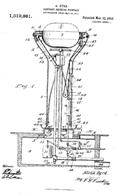
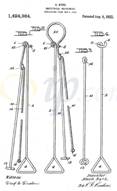
Atvill Byrd of Kansas City, Missouri, filed an application on May 15, 1911, for a sanitary drinking fountain for horses and other quadrupeds. The principal object was to provide a fountain which can be safely used on public thoroughfares without danger of spreading contagious diseases, such as glanders, etc., common to equines. The patent was approved on March 12, 1912. Byrd filed an application to patent an obstetrical instrument on May 20, 1920. The instrument was patented on August 8, 1922.
| Henry Luther Feistner (1903) |
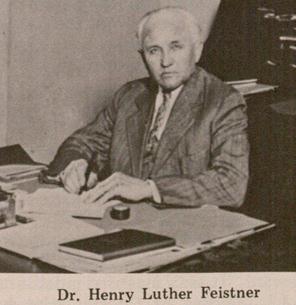 Henry Luther Feistner, son of Johann Michael Feistner and Anna Barbara Mueller, was born on December 3, 1875, in Farm Home, Johnson, Nemaha County, Nebraska, died on July 4, 1941, in Auburn, Nemaha County, Nebraska, at age 65, and was buried in Sheridan Cemetery, Auburn, Nemaha County, Nebraska. Both his mother and father were born in Bavaria. He was baptized in Stone Church by his uncle, the Reverend Leonard Feistner. He was educated in the rural schools in Nemaha County. He worked with William Ernst of Wolf Creek Stock Farm, importers of horses from 1898-1900 before he began his study of veterinary medicine.
Henry Luther Feistner, son of Johann Michael Feistner and Anna Barbara Mueller, was born on December 3, 1875, in Farm Home, Johnson, Nemaha County, Nebraska, died on July 4, 1941, in Auburn, Nemaha County, Nebraska, at age 65, and was buried in Sheridan Cemetery, Auburn, Nemaha County, Nebraska. Both his mother and father were born in Bavaria. He was baptized in Stone Church by his uncle, the Reverend Leonard Feistner. He was educated in the rural schools in Nemaha County. He worked with William Ernst of Wolf Creek Stock Farm, importers of horses from 1898-1900 before he began his study of veterinary medicine.
Lemonds notes that Feistner graduated from the Kansas City Veterinary College in 1903, Who's Who in Nebraska also notes this, but the Nebraskana notes that he graduated from the University Veterinary College in Kansas City, receiving the degree of D.V.S. in 1903. His name is not on the roster of graduates from the KCVC, but he may have received a degree from there later. He studied at the Western Normal College, Shenandoah, Iowa, from 1904-05. He practiced veterinary medicine first in Johnson and then in Auburn, Nebraska, beginning in 1905. In 1931, Dr. Feistner was appointed the State Veterinarian for Nebraska by Governor Charles W. Bryan (brother of William Jennings Bryan) and held the office for four years, 1931-35. On his return to Auburn in 1935, he was forced to discontinue his professional activities because of ill health.
Dr. Feistner was a member of the Nebraska Veterinary Medical Association, a member of the Nebraska State Veterinary Examining Board from 1922-27, the Red Cross, chairman of the Nemaha County Democratic Central Committee from 1920-30, the local Masonic Lodge and served several years as president of the Auburn Board of Education. He was very interested in youth and assisted in the sponsorship of the Boy Scouts and DeMolay organizations in his community.
H.L. Feistner, of Sun City, Arizona, a son of Dr. Feistner, wrote the following about life as the son of a Nebraska veterinarian in the early days:
"The years of 1929-30-31 were tough and several times dad and I would come home with eggs, chickens, or a slab of bacon for the call and be happy; those days made a barterer out of almost any professional man.
"The hardest thing in the world for Dad to do was inform a farmer that his tests on his dairy herd were positive for T.B. and they would have to be branded and shipped out—this really hurt because it usually meant a friendship lost.
"In the 1920's we castrated lots of horses, Dad could cut them standing or thrown, we could cut 5 to 15 head at each stop, and after Dad finished each colt he would say, 'Well, that's the best job I can do on this colt.'
"Sometimes farmers would tell Dad about remedies for animals he was treating, lots of suggestions but really no help. Dad would listen to all of them and when they would say 'What do you think about that, Doc?' Dad would turn to them with a half-smile and say 'You might as well grease a dog's ass for a bone in his throat.'
"When winter came to southeast Nebraska it really would stay. When the phone rang in the night Dad would go down stairs to answer. When he hung up the phone and I heard water being drawn in the tea kettle and put on the stove I knew it was time to start dressing as we were going out on a call. He would put his head in the bedroom door and say 'Let's go.' With the hot tea kettle of water, the Model T Ford rear wheel jacked up, Dad on the electric starter, and guess who on the hand crank, with water on the manifold, the old Model T would start to shake and the wheel with chains on it hit the garage floor and we were off on a cold ride with isinglass curtains and a manifold heater. Modernization took the fun out of veterinary medicine.
"One time we vaccinated several pigs and cut three colts for a farmer and after the work was done the farmer said, 'I haven't any money but a piggy sow due in about three weeks.' We loaded her in the back of the Model T and home we went. In three weeks, we had one sow and 13 pigs to take care of. At least the trip wasn't a dry run.
"I have seen Dad offered a case of home brew, or corn whisky for his trip but the person never offered it again. Liquor was one item Dad hated with a passion, never mention liquor or show it around the farm after a job and he would blow his mind. Just a word to the farmer and they understood each other.
"I have books (ledgers) which Dad kept in the early 1900's about his Livery Stable. He kept horses overnight for travelers for 25 cents for the evening, feeding, night stall, morning oats and hay. He also rented a team of horses and buggy to doctors in Auburn for 50 cents a trip to the country."
| Henry C. Babcock, M.D., (1904) |
Henry C. Babcock, M.D. was Second Vice-President from 1900-1901 and 1903-06; he taught Clinical Diagnosis and Examination for Soundness from 1898-1902. He earned his D.V.S. degree from the KCVC in1904.
| Emert Carter (1904) |
In the audience at one of Dr. Flynn's presentations was Dr. Emert Carter, Kansas City Veterinary College Class of 1904, and a World War I Army Veterinary Corps veteran. Dr. Carter had returned to Missouri as a partner in a Springfield practice. When his colleague died, he became the owner of a practice at 511 Convention Street, renaming it Carter's Animal Hospital. Here he built a practice largely specializing in the treatment of dogs and cats. Dr. Carter did not forget Dr. Flynn's lecture. In 1929, on a lot at 1009 St. Louis Street, he designed his version of Dr. Flynn's modern animal hospital. It was among the first, if not the first, Missouri clinic built from the ground up for the purpose—and maybe one of the first in the nation. This was no informal barn. Here, Dr. Flynn's clients were greeted by a receptionist in a separate room, a new concept in 1929. Clients were then led to a specialized examination room, another innovation. Dr. Carter's private office was nearby, for consultation. Away from the public's gaze were an instrument and drug storage room, operating room, general ward, isolation ward, laboratory, pharmacy, and exercise wards. The layout allowed one veterinarian to see several patients in an efficient, almost assembly line way. This new clinic was self-contained as well as efficient. In the pharmacy, Dr. Carter made his own medicines while still in hearing distance of his client. In the laboratory, he performed urine and blood analysis. He probably had one of the first x-ray machines dedicated to veterinary work in Missouri. As a purpose-built structure, the building featured extensive tile floors and walls for better sanitation and to convey the look of a hospital. A garage had a door that opened directly to the clinic, allowing Dr. Carter to rush sick patients in from his personal car or ambulance. As the clinic fronted the famous Route 66, he could buzz quickly to an injured animal and back again. A kitchen was located near the wards. Hospital staff members would prepare meals for clients and patients as the quality and availability of nearby restaurant food was undependable. A second floor was used as the living quarters for the veterinarian and his family. Dr. Carter operated the small animal clinic, and a related large animal practice, for 15 years before the stress of being on call 24/7 caused him to sell the business and get a job with the US Department of Agriculture. He died in 1971 at the age of 84 (From University of Missouri Veterinary Medical Review, pp. 16-17, Spring/Summer, 2005).
| Frederick Cleveland Cater (1904) |
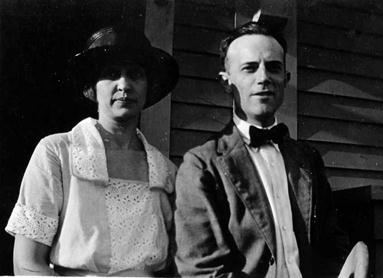 Frederick Cleveland Cater was born in Missouri on November 19, 1882, enrolling in the KCVC in 1902. The American Journal of Veterinary Medicine, Vol. 8, page 700, notes that Dr. Fred C. Cater, formerly of the Bureau of Animal Industry (BAI) Rinderpest-Serum Laboratory in Manilla, has associated himself with Dr. J.H. Oesterhaus of the "Big O" Serum Company in the manufacture of antihog-cholera serum. Cater may have also served in World War I, and he practiced in Sedalia, Missouri. In the American Journal of Veterinary Medicine, May 1916, page 435, Dr. Cater is listed as being associated with the Big Serum Company, Office 465, Livestock Exchange, Kansas City; the ad indicates that he was formerly the veterinarian with the Government Serum Laboratories in the Philippines. Also associated with the Big Serum Company was Dr. J.H. Oesterhaus, a graduate of KSAC, KCVC (1905), and a Late Veterinarian in the U.S. Army. Dr. Cater was the Deputy State Veterinarian for Missouri with the State Board of Agriculture from 1919-20. The January 1922 issue of "Veterinary Medicine" published a report of a meeting of the Missouri Valley Veterinary Medical Association in June 1921 where Dr. Cater made a presentation titled, "The Revision of Ethics to Meet the Needs of the Modern Veterinarian." Dr. Cater's granddaughter, Meg Berrian, donated his composite photograph for the Class of 1904 and other documents to the Kansas State University Archives. (Photo: Fred and Alma Cater, Sedalia, MO)
Frederick Cleveland Cater was born in Missouri on November 19, 1882, enrolling in the KCVC in 1902. The American Journal of Veterinary Medicine, Vol. 8, page 700, notes that Dr. Fred C. Cater, formerly of the Bureau of Animal Industry (BAI) Rinderpest-Serum Laboratory in Manilla, has associated himself with Dr. J.H. Oesterhaus of the "Big O" Serum Company in the manufacture of antihog-cholera serum. Cater may have also served in World War I, and he practiced in Sedalia, Missouri. In the American Journal of Veterinary Medicine, May 1916, page 435, Dr. Cater is listed as being associated with the Big Serum Company, Office 465, Livestock Exchange, Kansas City; the ad indicates that he was formerly the veterinarian with the Government Serum Laboratories in the Philippines. Also associated with the Big Serum Company was Dr. J.H. Oesterhaus, a graduate of KSAC, KCVC (1905), and a Late Veterinarian in the U.S. Army. Dr. Cater was the Deputy State Veterinarian for Missouri with the State Board of Agriculture from 1919-20. The January 1922 issue of "Veterinary Medicine" published a report of a meeting of the Missouri Valley Veterinary Medical Association in June 1921 where Dr. Cater made a presentation titled, "The Revision of Ethics to Meet the Needs of the Modern Veterinarian." Dr. Cater's granddaughter, Meg Berrian, donated his composite photograph for the Class of 1904 and other documents to the Kansas State University Archives. (Photo: Fred and Alma Cater, Sedalia, MO)
| Charles B. Eastman (1904) |
Charles B. Eastman served in the Spanish American War and was on "strike breaking" duty during the silver miners' strike in Leadville, Colorado, in 1896. He earned a B.S. degree from KSAC in 1902 and a D.V.S. degree from the KCVC in 1904. He was a practitioner of veterinary medicine and surgery from 1904-06 and Professor of Veterinary Anatomy and Physiology, San Francisco Veterinary College, 1906-08. He was a Veterinary Inspector, Bureau of Animal Industry (BAI), U.S. Department of Agriculture, 1908-1912. From 1912 to 1914, he was a veterinarian and stockman, 668 Marsh Street, San Luis Obispo, California. (From: Record of the Alumni of the Kansas State Agricultural College, Manhattan, Kansas, Kansas State Agricultural College, Department of Printing, 1914)
| Logan Barnett Huff (1904) |
Logan Barnett Huff was born in Quinton, Missouri, a town between Rockport and Maryville, and north of St. Joseph. He had two brothers who graduated from the KCVC: T.B. Huff graduated in 1908 and John in 1910. Riding on the coattails of the federal Meat Inspection Act of 1906, the Huff brothers found work with the Bureau of Animal Industry (BAI) as meat inspectors. Although they may have been lured to college by the promise of good work at the BAI, they soon found new opportunities in industry in the manufacture of hog cholera antiserum (Lofflin 2009).
| Albert Thomas Kinsley (1904) |
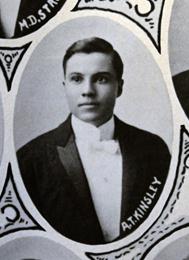 Albert Thomas Kinsley was born in Independence, Iowa, February 26, 1877. He received his B.S. degree from KSAC in 1899 and M.S. degree in 1901. He studied pathology at the University of Chicago and graduated from the KCVC in 1904. The KCVC Bulletin No. 12 (1906) has a report on rabies by Dr. Kinsley. On June 19, 1908, Kinsley was one of the speakers at a KSAC banquet in Manhattan, Kansas (KCVC Bulletin No.20, 1908). In 1910, Kinsley was President of the American Serum Company and was filling numerous orders for anti-hog cholera serum (KSCV Bulletin No. 27, 1910). He also had a text book in veterinary pathology, published by Alexander Eger of Chicago in press (KCVC Bulletin No. 27, 1910). A successful practitioner, he purchased an interest in the KCVC in 1912, became its president in 1913, and taught pathology, bacteriology, and parasitology from 1902-18. Kinsley served as Second Vice-President of the KCVC from 1909-13, President from 1913-17, and Dean from 1918-27 when the corporation was dissolved. On May 1, 1917, the laboratories of Dr. Kinsley became the firm of The Kinsley Laboratories, Ashe Lockhart (KCVC 1915) having become associated with Dr. Kinsley (KCVC Bulletin No.56, 1917). Beginning in 1918 he devoted his time to the Kinsley Laboratories in Kansas City and an extensive consultation practice. He is the author of a textbook on veterinary pathology and two on the diseases of swine. A frequent contributor to the veterinary periodicals, he pioneered a section on swine practice in Veterinary Medicine at a time when very little was known outside the Midwest. He was president of the AVMA in 1921-22. He died December 8, 1941.
Albert Thomas Kinsley was born in Independence, Iowa, February 26, 1877. He received his B.S. degree from KSAC in 1899 and M.S. degree in 1901. He studied pathology at the University of Chicago and graduated from the KCVC in 1904. The KCVC Bulletin No. 12 (1906) has a report on rabies by Dr. Kinsley. On June 19, 1908, Kinsley was one of the speakers at a KSAC banquet in Manhattan, Kansas (KCVC Bulletin No.20, 1908). In 1910, Kinsley was President of the American Serum Company and was filling numerous orders for anti-hog cholera serum (KSCV Bulletin No. 27, 1910). He also had a text book in veterinary pathology, published by Alexander Eger of Chicago in press (KCVC Bulletin No. 27, 1910). A successful practitioner, he purchased an interest in the KCVC in 1912, became its president in 1913, and taught pathology, bacteriology, and parasitology from 1902-18. Kinsley served as Second Vice-President of the KCVC from 1909-13, President from 1913-17, and Dean from 1918-27 when the corporation was dissolved. On May 1, 1917, the laboratories of Dr. Kinsley became the firm of The Kinsley Laboratories, Ashe Lockhart (KCVC 1915) having become associated with Dr. Kinsley (KCVC Bulletin No.56, 1917). Beginning in 1918 he devoted his time to the Kinsley Laboratories in Kansas City and an extensive consultation practice. He is the author of a textbook on veterinary pathology and two on the diseases of swine. A frequent contributor to the veterinary periodicals, he pioneered a section on swine practice in Veterinary Medicine at a time when very little was known outside the Midwest. He was president of the AVMA in 1921-22. He died December 8, 1941.